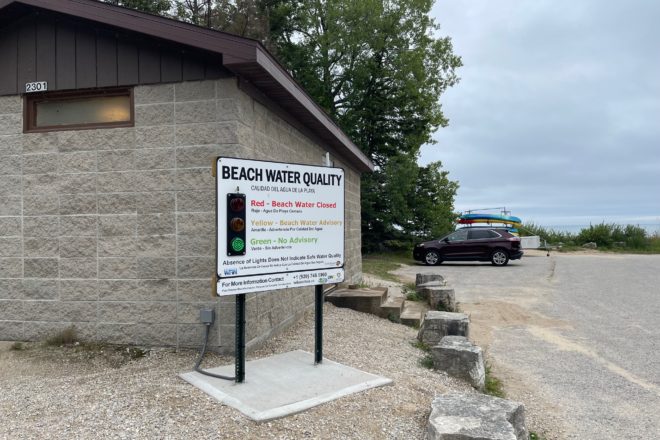Village Amending Code that Conflicts with Beach Water Quality Sign
- Share
- Tweet
- Pin
- Share

The County of Door took another shot at trying to convince the Village of Sister Bay to erect a cellular-connected sign that alerts the public about water quality at the beach and this time, gained some ground.
The county first installed the signs last year at five Door County beaches: Frank E. Murphy County Park in the town of Egg Harbor; Baileys Harbor Ridges County Park; Egg Harbor Beach; and, in Sturgeon Bay, Otumba Park Beach and Sunset Park Beach.
The county is transitioning from that first-year, pilot phase to attempting to integrate the signs at nearly all 30 beaches that are tested annually along the Door County coastline, prioritizing beaches that have the highest incident of closures, coupled with the most traffic, according to Tim Kazmierczak, Door County Parks director.
Last year, Sister Bay had four out of Door County’s 47 beach advisories and two of its 20 beach closures, Kazmierczak said. That, and the popularity of Waterfront Park, make it a priority location.
County Administrator Ken Pabich attended the village’s Plan Commission meeting, Jan. 23, to request the sign for the 2024 season, with Kazmierczak attending virtually. Last year, the village didn’t approve the request. This year, its Parks, Property & Streets Committee forwarded it to the Plan Commission to learn if the Commission would allow the sign.
Village Plan Commission Chair Denise Bhirdo, who also serves as a village trustee, started off the conversation not seeing a need for the sign.
“Sister Bay is pretty clean, and [the beach] rarely, rarely closed,” she said.
“It’s a tool to educate our public and the visitors,” Pabich said. “From a public health perspective, it’s a very important program.”
University of Wisconsin-Oshkosh students test 30 Door County beaches about three times per week between Memorial Day and Labor Day. When a sample shows a moderate-to-high level of E.coli, the student must travel to the beach to install a beach advisory or closure sign, and then remove it once the coast is clear. With the signs, the students can turn on the notification as soon as they receive the results.
“This reduces the notification process by 24-48 hours, which in turn greatly reduces the potential risk of infection to beachgoers,” Kazmierczak said.
“I think we can not have the signs and still have safety,” said Commissioner Nate Bell, who also serves as village board president.
He suggested the county call the village and they’d post the current sign that’s used when needed for an advisory or closure. Pabich said they’ve not had a student try to call a public official with a public health notification.
“Can it be done? Yes, but we never have,” Pabich said. “If you say no, we’ll try to work with you in another way.”
The ground-mounted, cellular-connected signs are about 39 inches by 48 inches. The lights do not engage during the evening hours, and Pabich and Kazmierczak said they could use a smaller sign and also mount it to a wall.
After more discussion, Bhirdo said she was “reluctantly OK with the smaller sign if it’s on the wall,” but they still had to deal with the village’s sign code.
The signs have a solar-powered stop-and-go light system – red means the beach water is closed, yellow means an advisory and green means the beach water is open. The village’s sign code says “signs shall not resemble, imitate or approximate the shape, size, form or color of traffic signs, signals or devices.”
“We would have to do a text amendment,” Bhirdo said, which will take some time. “We might get it done in a year, Ken [Pabich].”
“We’re in this as a community,” Pabich said. “If it takes this long, OK.”
“We’ll work on a text amendment and try to keep moving forward,” said Julie Schmelzer, village administrator.

